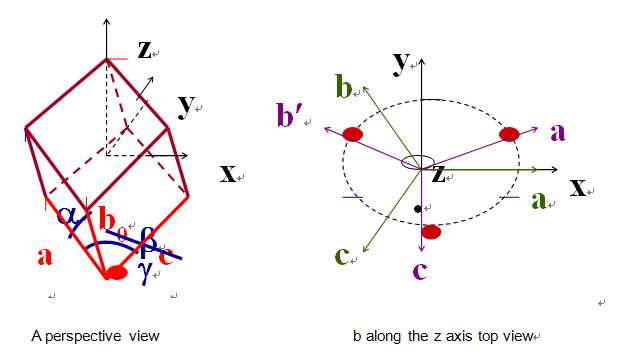

Lithium niobate modulator is fabricated by the electro-optic effect of lithium niobate crystal combined with the photoelectron integration process because of its high response speed, low insertion loss, and low half-wave voltage. It is widely used in fiber-optic communication, microwave photonics, fiber-optic sensing. And other fields. Today we introduce the electro-optic effect and application of lithium niobate crystals.
The lithium niobate crystal is a negative uniaxial crystal (no>ne), which belongs to the trigonal system and has a 3m point group symmetry operation.

Figure 1 depicts the selection of its unit cell structure and physical coordinate system.
As shown in Figure 1, the Z-axis is the 3rd axis of rotation, the y axis is in the plane of symmetry, and the x-axis is perpendicular to the symmetry plane. Such a crystal structure is destined to have an excellent thermoelectric effect, a piezoelectric effect, a bluing effect, an electro-optic effect, and the like.
The electro-optic effect refers to a phenomenon that causes a significant change in the refractive index of material under the action of a direct current electric field (or a low-frequency electric field). That is to say, and the applied electric field changes the optical properties of the medium. In some materials, the change in refractive index is linear with the strength of the applied electric field, the linear electro-optical effect, also known as the Pockels effect. The linear electro-optic product can be considered the second-order nonlinear polarization generated by mixing the incident light field and the DC electric field. The second-order nonlinear polarizability describes the linear electro-optic effect, and it can only be spatially nonlinear. In materials, with spatially balanced centers, such as liquid or glass, the change in refractive index is proportional to the square of the applied electric field. This is the secondary effect or the Kerr electro-optical effect. Similar to the linear electro-optic effect, it can be described by third-order nonlinear polarization. In addition to this, there are higher electro-optic effects. Electro-optic results can be expressed in mathematical expressions.
Which is:

As shown in Figure 1, the Z-axis is the 3rd axis of rotation, the y axis is in the plane of symmetry, and the x-axis is perpendicular to the symmetry plane. Such a crystal structure is destined to have an excellent thermoelectric effect, a piezoelectric effect, a bluing effect, an electro-optic effect, and the like.
The electro-optic effect refers to a phenomenon that causes a significant change in the refractive index of material under the action of a direct current electric field (or a low-frequency electric field). That is to say, and the applied electric field changes the optical properties of the medium. In the formula, γ and h are constants, and no is the refractive index of the crystal when no voltage is applied. The first term on the right side of the equation is the change in refractive index caused by the linear electro-optical effect. Because, in general, higher-order effects are much weaker than the primary effect in lithium niobate crystals, we only need to consider the linear electro-optical effect.
Application:
In an electrical communication system, the peak-to-peak value of the original rate digital signal level is only 0.8V. Since the half-wave voltage (Vp) of a lithium niobate modulator with a data rate greater than 2.5 Gb/s is high, a driver is required to drive the modulator. The driver must not only have a wide operating frequency band but also be able to provide a sufficiently large microwave output power. For example, for a 10 Gb/s, Vp=5.5V modulator, the driver is required to have an operating band of 75 kHz to 8 GHz and a 1 dB output power of 20 dBm (100 mW). Producing a rated driver is very difficult, so making a modulator with a low Vp is very popular.
Of course, the modulator is also required to have other good properties such as low optical insertion loss, large extinction ratio, small light reflection loss, weak electrical reflection loss, and suitable chirp parameters.
Electro-optic modulators have many uses. The phase modulator can be used in a coherent optical fiber communication system, a comb generator for generating multiple optical frequencies in a dense wavelength division multiplexing optical fiber system, and an electro-optical frequency shifter for a laser beam.
Electro-optic modulators have good characteristics for use in fiber-optic cable television (CATV) systems, optical links between base stations and relay stations in wireless communication systems, and other fiber-optic analog systems.
In addition to being used in the above systems for generating high repetition rates, very narrow optical pulses, or Solitons, electro-optic modulators are used as photonic broadband microwave phase shifters and frequency shifters in advanced radar deception systems. It is used as a photon time delay in microwave phased array radar, used in optical wave component analyzers, measuring weak microwave electric fields, etc.